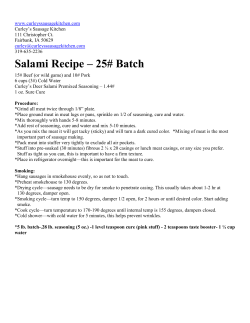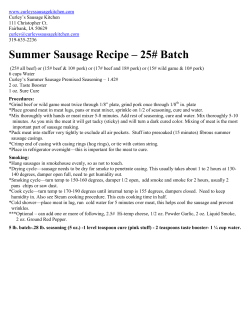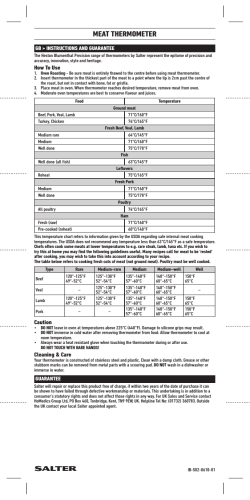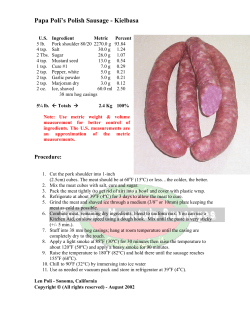
Meat Beef burger sliders
Meat Beef burger sliders 7-11 years Mini Chefs lesson plan Aims of the session • To introduce children to red meat and teach them how to prepare and cook fresh beef mince safely and to make burgers. • To enable children to name and use a range of basic cooking equipment (e.g. knife, chopping board). Introduction As a popular dish with young children, it is good to show what is in a burger and how it is made from scratch. A type of sandwich, it is thought that the word ‘hamburger’ comes from Hamburg in Germany. Beef is a good source of protein which is needed for growth and maintenance of normal muscles and healthy bones. Red meat is also a good source of iron, which is a mineral. Mince can be made from different types of meat, such as beef, lamb, turkey and pork, and can be made into a wide variety of meals, such as meatballs, spaghetti bolognese, cottage pie and lasagne. Cuts of meat are ground in a mincer (a machine), which grinds a larger piece of meat (the muscle) and forces it through small nozzles giving it its unique appearance and texture. • To provide the opportunity for children to demonstrate a range of basic food preparation skills (e.g. grate, bridge and claw cutting techniques). • To teach children about the nutrients provided by red meat. • To learn the sensory properties of meat, give their opinion about these and use some sensory vocabulary to describe the ingredients used to make a burger. Children will • recall and carry out the personal hygiene drill, with support • learn how to make burgers and perform the necessary food preparation skills safely and hygienically (e.g. handling raw and cooked meat safely and washing hands and knives and boards) • evaluate the taste and appearance of their dish Minced beef should be cooked thoroughly to destroy harmful bacteria (there should not be any pink in the centre of the burger). • be encouraged to build their skills and confidence by making the dish again at home as part of a family meal It is important that raw and cooked meat are prepared and kept separate (including washing hands between handling, using different knives, boards and plates). Skills Peeling, chopping, grating, mixing, shaping, slicing and presenting. 1 Outline of activity 1. Discuss the activity with the children - show them examples of different meat cuts and how mince is made using a mincer (pictures or video): http://meatandeducation.redmeatinfo.com/resources/downloads/posters/making-mince http://meatandeducation.redmeatinfo.com/resources/teacher-cpd/interactive-whiteboard-activities 2. Demonstrate the recipe and discuss the key skills - emphasise the need to work safely and hygienically, e.g. washing hands. 3. Make the recipe in groups of four children. 4. Serve and eat the burgers. What you will need Ingredients For 1 group For 2 groups For 3 groups For 4 groups Small onion 1 2 3 4 Small carrot 1 2 3 4 250g 500g 750g 1kg 1 teaspoon 2 teaspoons 3 teaspoons 4 teaspoons 2 tablespoons 4 tablespoons 6 tablespoons 8 tablespoons 2 teaspoons 4 teaspoons 6 teaspoons 8 teaspoons 1 level teaspoon 2 level teaspoons 3 level teaspoons 4 level teaspoons 2 4 6 8 4cm piece 8cm piece 12cm piece 16cm piece 8 16 24 32 8 leaves 16 leaves 24 leaves 32 leaves For 1 group For 2 groups For 3 groups For 4 groups Box grater 1 2 3 4 Chopping board 1 2 3 4 Small vegetable knife 2 4 6 8 Vegetable peeler 1 2 3 4 Fork 2 4 6 8 Measuring spoons 1 2 3 4 Non-stick baking tray with rim 1 2 3 4 Mixing bowl 1 2 3 4 (4 children) Lean beef mince Dried mixed herbs Tomato ketchup Worcestershire sauce Dijon mustard (8 children) (12 children) (16 children) Black pepper Tomato Cucumber Small wholemeal roll Little gem lettuce Ingredients (4 children) (8 children) (12 children) (16 children) Oven gloves, one pair per oven 2 How to run the session Before the children arrive Some children may not eat meat for religious reasons or beliefs. If so, consider how this session could be adapted to be inclusive. • Store fresh food covered in the fridge until it is needed. The meat should be kept refrigerated until the last moment. • Set out the equipment needed for each group. • Set out the ingredients required. • Set out the demonstration area with all ingredients and equipment listed. • Get the recipes and aprons ready. • Prepare the room and tables. Display the recipe on the whiteboard and/or provided copies of the recipe on the table for children to follow. • Make sure you preheat the oven. If it is not in the same room, ensure that others in the school know that it is being used. Activity You’ll need: Introduction Recipe on the whiteboard/ copies of recipes for the children to read through Explain to the children that they will be making mini burgers, that are called sliders in the USA. Get ready to cook Ensure that all the children are ready to cook. Children should follow the personal hygiene drill: You’ll need: Aprons, sink, soap and hand towels • tie up long hair • remove jewellery • roll up long sleeves • wear an apron • wash their hands Curriculum links England - D&T: Cooking and nutrition, Science Scotland - Health and wellbeing, Technologies Northern Ireland - The world around us Wales - D&T: Food, PHE 3 Activity Inspire the children • Discuss the different recipes (show images) that use mince (e.g. burgers, meatballs, lasagne). • Ask them about the meat – which animal it is from? Explain about the different types of meat that are available (e.g. beef, turkey, lamb and pork). How many have they tasted? Are they different? • Talk about how red meat is a good source of iron. It is also a source of protein, which supports the growth and maintenance of normal muscles and healthy bones. It’s important to eat a varied and balanced diet as part of a healthy lifestyle. • Explain that some people do not eat meat for religious reasons or their beliefs. • Why is meat kept in the fridge? It is to keep it safe and reduce the multiplication of bacteria. • Go through the recipe so that children understand your expectations. Demonstration • Demonstrate how to cut the onion using a fork secure (or bridge hold and claw grip). • Show how to grate the carrot safely (repositioning the carrot as it gets smaller in order to keep fingers away from the grater blades). You’ll need: Images Demonstration ingredients and equipment • Show how to shape the burgers. Remind children to wash their hands after touching raw meat. • Show how to test if they are cooked, and ask them to make sure you have checked their burgers. You can show children at the end of the cooking activity if you are not able to cook a portion of burgers in advance. Get cooking! • Divide the children into groups of four. • Ask children to check they have the correct equipment, according to the recipe. • Ask the children to measure and weigh the ingredients required. Check their measurements are accurate and ask them to work together to check each others’ measurements. • Supervise the children setting the oven to the correct temperature, if the oven is in the same room. • Children will need to wash their hands during this activity. If the room does not have running hot water, ensure that a washing-up bowl with hot water, soap and a hand-towel is available. • Meat is kept in the fridge until needed – remind them why. 4 Activity Keep cooking! • Ensure that any knives, boards or plates that are reused (after having raw meat on them) are washed thoroughly so that no cross contamination can occur. • Check for correct cutting techniques - it is important that the onion is small so that the burger does not fall apart. • Use oven gloves when placing items in and taking items out of the oven. • While the burger is cooking, prepare the roll and salad items (ensure the children have washed their hands since the last time they had contact with the raw burger). • Use a bread knife to slice the bread rolls through the middle (an adult should do this or supervise children doing it). • Slice the cucumber using the claw grip (or supervise children doing it). • Slice the tomato using the bridge hold - half the tomato, place a half flat side down, secure it with a fork (or claw grip) and slice. Make sure the knife is sharp enough or serrated, as a blunt knife will tear the tomato. • Check there is no pink meat undercooked in the middle of a burger, pierce with a sharp knife and check juices run clear. • When the burger is cooked, assemble it in the roll with the salad. How to finish this activity • Children should serve and eat their burger while hot. It is not recommended that these are stored/or reheated (the burger roll will go soggy and it may not be safe to reheat). • Ask if the children made this again, how could they improve the burger? Encourage them to be creative: - What mince could they use? (For example, lamb, beef, pork or turkey.) - What flavourings could they add? (For example, herbs, spices or sauces.) - What could they serve with the burger, e.g. different leaves, different buns or rolls? - What vegetables could they add? (For example, grated courgette, chopped mushrooms or diced peppers.) You’ll need: Plates and napkins Copies of the recipe for the children to take home • Ask children if they liked making the burgers and would make it again at home for their families. • Provide the children with a copy of the recipe to take home – encourage them to make this with their parents/carers. Useful links For basic food skills in primary schools, including videos demonstrating cutting, peeling and grating and support around where food comes from, visit www.foodafactoflife.org.uk 5
© Copyright 2026









